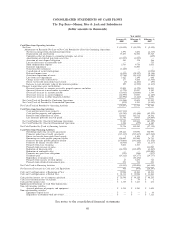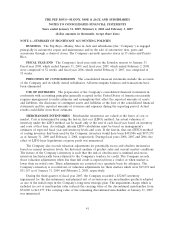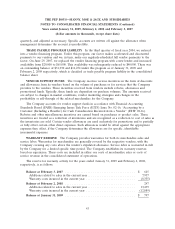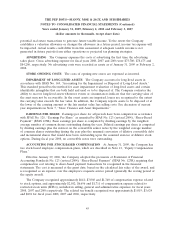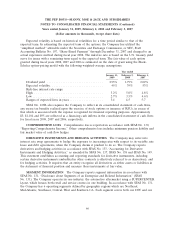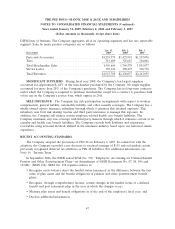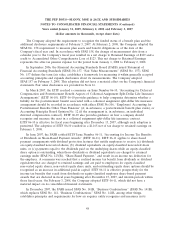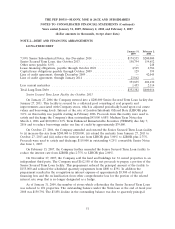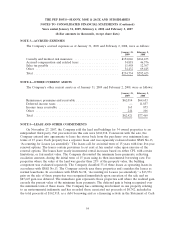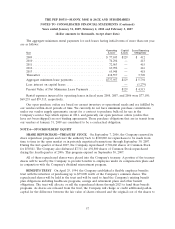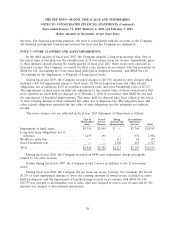Pep Boys 2008 Annual Report Download - page 113
Download and view the complete annual report
Please find page 113 of the 2008 Pep Boys annual report below. You can navigate through the pages in the report by either clicking on the pages listed below, or by using the keyword search tool below to find specific information within the annual report.THE PEP BOYS—MANNY, MOE & JACK AND SUBSIDIARIES
NOTES TO CONSOLIDATED FINANCIAL STATEMENTS (Continued)
Years ended January 31, 2009, February 2, 2008 and February 3, 2007
(dollar amounts in thousands, except share data)
financial statements the identifiable assets acquired, the liabilities assumed and any controlling interests
in the acquired entity; recognizes and measures the goodwill acquired in the business combination or a
gain from a bargain purchase; and determines what information to disclose to enable users of the
financial statements to evaluate the nature and financial effects of the business combination. Costs of
the acquisition will be recognized separately from the business combination. SFAS No. 141R applies
prospectively, except for taxes, to business combinations for which the acquisition date is on or after
the beginning of the first annual reporting period on or after December 15, 2008. The Company is
currently evaluating the impact SFAS No. 141R will have on its consolidated financial statements
beginning in fiscal year 2009 in the event of an acquisition by the Company.
In December 2007, the FASB issued SFAS No. 160, ‘‘Noncontrolling Interests in Consolidated
Financial Statements—an amendment of ARB No. 51’’ (SFAS No. 160). SFAS No. 160, among other
things, provides guidance and establishes amended accounting and reporting standards for a parent
company’s noncontrolling interest in a subsidiary. SFAS No. 160 is effective for fiscal years beginning
on or after December 15, 2008. The Company does not expect the adoption of SFAS No. 160 to have a
material impact on its financial condition, results of operations or cash flows.
In February 2008, the FASB issued Staff Position No. FAS 157-2 (FSP No. 157-2), ‘‘Effective Date
of FASB Statement No. 157’’ (FSP No. 157-2) that defers the effective date of SFAS No. 157 for one
year for certain nonfinancial assets and nonfinancial liabilities. SFAS No. 157 is effective for certain
nonfinancial assets and nonfinancial liabilities for financial statements issued for fiscal years beginning
after November 15, 2008. The Company does not expect the adoption of FSP No. 157-2 to have a
material impact on its financial condition, results of operations or cash flows.
In March 2008, the FASB issued SFAS No. 161, ‘‘Disclosures about Derivative Instruments and
Hedging Activities—an amendment of FASB Statement No. 133’’ (SFAS No. 160). SFAS No. 161
requires increased qualitative, quantitative, and credit-risk disclosures. Qualitative disclosures include
how and why an entity uses derivatives or hedging activity, how the entity is accounting for these
activities and how the instruments affect the entity’s financial position, financial performance and cash
flows. Quantitative disclosures include information (in a tabular format) about the fair value of the
derivative instruments, including gains and losses, and should contain more detailed information about
the location of the derivative instrument in the entity’s financial statements. Credit-risk disclosures
include information about the existence and nature of credit risk-related contingent features included in
derivative instruments. Credit-risk-related contingent features can be defined as those that require
entities, upon the occurrence of a credit event (e.g., credit rating downgrade), to settle derivative
instruments or to post collateral. SFAS No. 161 is effective for financial statements issued for fiscal
years and interim periods beginning after November 15, 2008. The Company does not expect the
adoption of SFAS No. 161 to have a material impact on the Company’s consolidated financial
statements.
On May 9, 2008, the FASB issued SFAS No. 162, ‘‘The Hierarchy of Generally Accepted
Accounting Principles’’ (SFAS No. 162). This statement reorganizes the GAAP hierarchy. The purpose
of the new standard is to improve financial reporting by providing a consistent framework for
determining what accounting principles should be used when preparing U.S. GAAP financial
statements. The Board believes that the previous GAAP hierarchy under SAS 69 was flawed because it
(1) was directed to auditors, not entities, who are ultimately responsible for preparing U.S. GAAP
financial statements; (2) was too complex; and (3) did not properly rank the accounting literature. In
49



